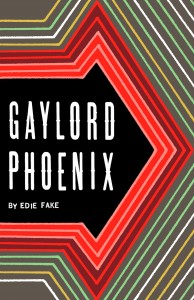The moment I saw Edie Fake‘s book Gaylord Phoenix (Secret Acres, 256 pages, $17.95) on a table at a local shop was a lifesaver. Not much contemporary art or stuff actually reaches me — and jolts me — at the mysterious and elusive spot(s) where my imagination and spirit reside, and the drawings and stories of Fake do exactly that. I have some issues of Gaylord Phoenix from when it was in serial form, and Fake’s comic Rico McTaco, but I had no idea a lavish color book of Gaylord Phoenix existed, and the discovery was about as close to finding a treasure as I’ve had in recent daily life.
Over the last few weeks I’ve looked at Gaylord Phoenix a lot in bed, on the verge of sleep and dreams, and occasionally while in transit from one place to another. Both experiences, if not ideal, seem right for entering the book’s universe. It is the kind of epic journey in which a reader — not to mention the characters — can get lost. Gaylord Phoenix is a love and lust story. It’s a quest through terrain that is strange yet also familiar, especially if you have access to your queerness or inner experience. It is funny, it is disturbing, it is gorgeous, it is mesmerizing.
Gaylord Phoenix the character has a projector for a nose; webbed hands which can morph into other shapes; a hairy chest, arms, and legs; and (most of the time) tubular genitals that can penetrate and be penetrated, fill or envelop. There is a slightly woeful or stricken quality to Gaylord’s personality, as rendered via facial features and half-capsule head. Yet hexes, spells, “crystal bloodlust,” orgiastic oceans of tears, experimental examination rites, and periods of bereft solitude are not enough to stop Gaylord Phoenix from searching for pleasure and communion with the surrounding world.
That world — a world of many worlds — is one of the things that makes Gaylord Phoenix special. Fake’s hand-rendered cubes, pyramids, hexagons, Bridget Riley-like black-and-white vortexes (referred to in the ultra-spare, brilliant dialogue), wizard cone hats, mazes, temples, wood grains and vines, crocodile skins, fish scales, clouds and cave formations, and plumage accumulate detail and color over the course of the book. What might have been interpreted as technical improvement within Gaylord Phoenix‘s serial manifestations as a comic is revealed in the book to be material for a dramatic and visionary climax and denoument.
In the realm of comics and graphic novels, Gaylord Phoenix could be seen as a fantastic inverse of the sexual horror in Dash Shaw‘s BodyWorld. It arrives at a time when various musicians and visual artists are also tapping into mystic and occult energy, though its singularity of vision reminds me of Jack Smith and Kenneth Anger channeled from archival celluloid strip to contemporary line drawings on the printed page. Ultimately, there is nothing like it.
A few years ago, Fake lived in SF, and attended one of the Guardian’s Goldies celebrations with Amanda Kirkhuff, whose pencil drawings and oil paintings of female pop icons and news figures transmit an equally pure power. They aren’t here now, they’re each moving onward in their own ways, but this city was lucky to play host to them for a while, and it would be great to see them again.

